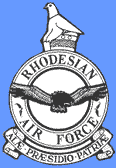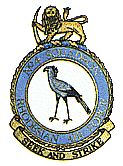4 Sqn Photos
Squadron Commanders and the History
Roll of Honour
Umtali Affiliation
Ferry Flight from UK
Air Force Home Page
Formation
No 4 Squadron was formed in
January 1956.
Motto
"Seek and Strike"
Roles
The role of No 4 Squadron was that of support of the army on
Internal Security Operations.
This was later modified in 1969 with the introduction of the Trojan aircraft to include light transport, reconnaissance, forward air control, casevac and light ground attack.
History
No 4 Squadron was originally formed as an Internal Security support squadron. It was originally based at Thornhill Air Base in Gwelo. It operated the Percival Provost (T52) aircraft until they were replaced in 1967 by the Lockheed Aeromachi AL60 Trojan aircraft. The remaining Provost aircraft were transferred to No 6 Squadron.
1967
1967 saw the arrival of the first Lockheed Aeromachi AL60 B
“Trojan” aircraft. Assembly began on 1st August
1967 and the 9th aircraft was completed on the 24th August.the final
aircraft was completed on the 6th September.
The
Squadron deployed to Wankie to evaluate the role of the Trojans in the
reconnaissance role and to train both pilots and engineers in the finer
points of observation.
1968
In January
1968 No. 4 Squadron for the
first time, employed Trojan aircraft on operations
The squadron carried out message dropping trials with great accuracy. The message streamer consisted of a bag about 6 inches length divided into two pockets, one of about 2 inches square and the other about 4inches by 2 inches. The smaller pocket was filled with sand and sealed (this provided stability) whilst the other had a flap that was sealed using "Velcro", Into this was placed the message). A long pierce of material (4 to 6 feet) was stitched to the outside end of the message pocket. To drop the message the pilot held the message bag and streamer all rolled up in has left hand, positioned the aircraft for a low pass over the troops to whom he wanted to drop the message and holding his hand out of the window, released it just before flying over the intended recipients. As the message was released the streamer would unravel, causing drag which retarded the speed of the message bag and it fell rapidly to the ground, for retrieval.
In March of 1968 Operation Spiderweb, (to test the capabilities of the Trojan), was curtailed as Operation Cauldron broke.
1969
7th January 1969 Cessna Crashed killing Lieutenant Johan van Heerden
(South African Police) and seriously injuring Flight Lieutenant Don
Annandale.
May 1969 saw No 4 Squadron carry out trials to conduct night landings using Land Rover headlights to illuminate the runway threshold.
June 1969. No. 4 Squadron Awarded the Jacklin Trophy for 1968.
5th July 1969 Trojan R3421 piloted by Flying Officer Brian Penton with engineer Corporal Mike Jamison was involved in an accident at the Bumi River Airstrip. The damage to the aircraft was Category 5.
No 4 Squadron in conjunction with No 1 Squadron continued to work on airborne Forward Air Control (FAC) which had first been used in 1968.
October 1969 two Trojans of No 4 Squadron (Flight Lieutenant Ken Law and Air Lieutenant Ed Paintin) engaged on a search and rescue for Air Lieutenant Jim Stagman and Flight Lieutenant Dave Postance who ejected from their Canberra aircraft over the Wankie National Park.
1970
May 1970 Very Pistol trials were continued
to try to find a better method of marking the target for Forward Air
Control. A previous trail resulted in hundreds of acres of farmland
being set on fire.
15th
September 1970 a Trojan flown by Air Lieutenant Beav Baynham suffered
an engine failure at night whilst carrying out the casualty evacuation
of Game Warden Paul Coetzee( who had been gored in the groin by a
rhinoceros) from Tchoda to Salisbury. All on board the aircraft were
uninjured.
14th October 1970 Flight Lieutenant
Gordon Wright with Mike Parker as engineer, suffered a similar engine
failure and forced landed in a field. On this occasion the casevac who
was suffering from sleeping sickness was slightly injured sustaining a
cut to the head.
1973
20th May 1973 Air Sub Lieutenants Clive Ward, Mark Aitchison and Cocky
Benecke posted to No. 4 Squadron.
Air Lieutenant Greg Todd‘s Provost was hit by ground fire. The the bullet passed through the base of the starboard seat and smashed the starboard windscreen. Fortunately, the seat was not occupied.
Flight Lieutenant John Carhart had an accident in Trojan R3421 at Sipolilo.
September 1973 Air Lieutenant Mike Litson damaged the wing of a Trojan when he pulled out of an attack on a group of terrorists too low.
On the 25th October 1973 Air Sub Lieutenant
Mark Knight whilst carrying out a night casevac using Land Rover
headlights to illuminate the runway, struck 3 cows just as he reached
flying speed. The pilot and passenger were not injured but the aircraft
suffered severe damaged to the propeller, nose-wheel, and tail plane.
1974
On Sunday 14th April 1974 a Trojan flown by Flight Lieutenant
Chris
Weinman with Technician Senior Aircraftman Patrick Durrett was shot
down by fire from 12.75
and 14,5 mm anti-aircraft guns whilst on a
reconnaissance mission over Mocambique . An intensive air search was
launched
for the aircraft.
Two Hunters searching for
the
Trojan were fired at with SAM-7 heat seeking missile. This was the
first occasion that a strella missile was known to have been used
against Rhodesian aircraft.
Six
days later
on the 20th April 1974 Trojan 3427 with Air Sub Lieutenant R.Wilson and
Flight Sergeant Rob Andrews was downed by a surface to air missile in
the same area in Mocambique whilst searching for the aircraft of Chris
Weinman. Both crew members were killed and the aircraft destroyed.
On the 16th August 1974 a Provost flown by Flight Lieutenant Steve Baldwin and a student, was damaged when it ran into a ditch that had been dug across the runway at Centenary.
On the 17th December 1974 Trojan 4326 was written off when it crashed during take off at Mashumbi Pools in the north of the country. The crew Air Lt Brian Murdock and Corporal Mike Parker were conducting the casualty evacuation of Lance Corporal R. J. Pove (army) at night. During the take off run the aircraft struck an army land rover shortly after getting airborne. The aircraft was destroyed and all on board were killed.
1976
On the
20th April 1976 Trojan 3425 was damaged (Cat 3) when Air Lieutenant Ian
Sheffield carried our a forced landing near Mtoko in the North East of
the country.
In 1976 the Trojan aircraft were
supplemented by Reims FTB 337 Lynx aircraft.
2nd September 1976 saw the loss of the first Lynx (R3413) aircraft flown by Flight Lieutenant "Bill" Stevens. The aircraft was hit by ground fire when it was lured into an ambush on the North Eastern border with Mocambique. The aircraft was destroyed and Bill Stevens killed. This was a particularly sad loss, as Bill who had initially qualified as a Navigator re-mustered for pilot training. Having qualified as a pilot he was posted to No 4 Squadron and was killed during his first operational tour.
1977
On the 14th March 1977 Lynx R4321 was destroyed when it
forced landed near Mtoko Air Lieutenant J. Kidson and Lieutenant
Colonel Brian Robinson (SAS) survived.
Two months later on the 4th May 1977 Lynx R4306 crewed by Air Sub Lieutenant Rob Griffiths and Aircraftsman C.W. D. Brown was destroyed south of Umtali. Regrettably Aircraftsman Brown was killed.
On 2nd September (one year after the first Lynx was lost) Lynx R3042 was shot down near Umtali killing Air Lieutenant D. L. du Plessis and Sergeant J. S. Underwood.
Post Zimbabwe
Independence
When the Trojans were sold off
post independence the squadron continued to operate the Lynx in
the Internal Security role.



















